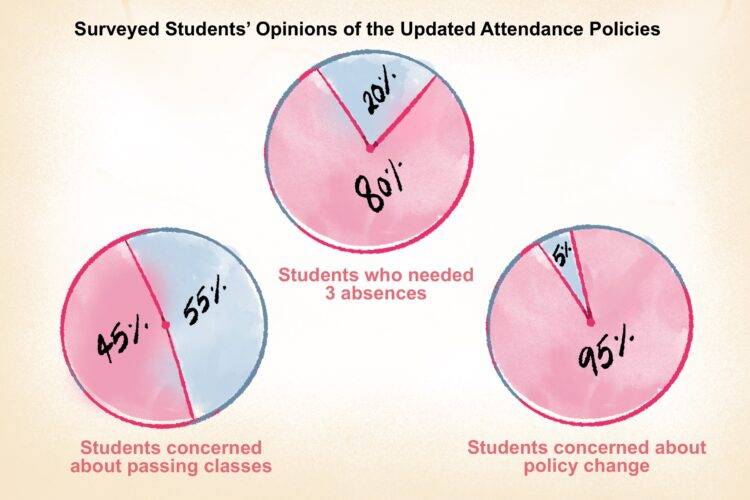
On the night of Wednesday, Aug 28, my two best friends and I were having a hazy conversation about the attendance policy. After a frenzied first day of classes, we were all left with a complex question: Had the School of the Art Institute of Chicago’s attendance policy changed?
The next day, one of my teachers explained the changed policy to my class. Under the most updated school policy, students are allotted two absences per course. Evidently, most of the other students were unfamiliar with the new policy change until my teacher mentioned it.
The attendance policy throughout COVID-19 had no specific number of absences. Most students were told they were allowed three absences per course, but there was no official policy allowing three.
Last year’s student handbook said, “Ultimately, faculty will give credit to students enrolled in a course only if they have responded adequately to the standards and requirements of the course overall.”
Prior to mid-2020, the official attendance policy read, “No more than two absences are permitted. If you are absent from class two times (or the equivalent of six hours), you will receive a Course Progress Report from the Office of Student Affairs/Academic Advising. Missing class more than two times for any reason, whether or not for reasonable cause, will result in No Credit for the course.”
Officially, the school has not explicitly notified students about the 2024-25 school year change; however, in the updated 2024-25 student handbook the attendance policy states, “At the discretion of the instructor, students may be permitted a maximum of two absences per semester.” This leaves it up to teachers’ discretion to tell their students about it. (Though professors are required to include the attendance policy in their syllabi, which they submit to the school.)
There’s a notable discrepancy between the policy being a strict cutoff at two absences, and the policy being at the discretion of teachers.
There’s also a discrepancy in how many absences are individually allowed by teachers. Some faculty say students can miss two classes, and after the third they lose credit. Others say that students lose course credit after the second absence. Some faculty say that missing a critique day counts as missing two classes. There is no official specification about when, exactly, students lose course credit.
In order to better understand the student’s perspective, F Newsmagazine sent 98 students a survey to gauge their opinions on the change. Of those solicited, 16 responded.
“[The schedule change is] a bit ridiculous. I feel as though the new policy doesn’t take into account that we pay for the classes and are wasting our own money and education if we choose not to attend, that should be our only punishment. We’re not high schoolers,” said student Emily Griffith (BFA 2025).
Digeo Jiménez (BFA 2027), said, “I understand why this policy exists. We often only meet for a class once a week and if you miss even a handful of those times you miss a huge portion of content being covered. However, I feel like this wasn’t the kindest way to go about this. Some teachers are open about being lenient if you communicate while others seem to use this rule as justification to be extra harsh.”
Jimenez added that he would prefer more absences, especially in light of the ongoing COVID-19 pandemic. Encouraging sick students to come to class is “fundamentally dangerous,” he said.
F Newsmagazine sent 20 faculty members a survey to understand their perspectives of the updated policy. Of the 20 faculty who were sent the survey, six responded.
“I’m actually grateful to have a clear, written, school wide policy for attendance. It has been difficult and frustrating in the past to feel uncertain about how to interpret the more unclear version prior to the pandemic,” said professor Beth Hetland. She added, “I am concerned about folks having not read the guidelines. That there may be some difficult conversations later in the semester and more appeal requests.”
“So, for me, the new policy doesn’t fundamentally change how I approach attendance.[…] Maybe naively, at least for many lecture-based courses, I think the new framework emphasizes that students are still responsible for the ideas they missed (good thing from my perspective) — although, without adequate support this could go sideways quickly,” said lecturer Luna Jaskowiak.
Stripe Gandara, associate dean of undergraduate studies, noted the need for policy changes to align with COVID-19 protocols.
“To inform the new policy, the deans began by collecting feedback from students and faculty on their perspectives on class attendance. Common themes that emerged were the need for a clear institutional standard, a policy well aligned with [Disability and Learning Resource Center] accommodations, and space for faculty to adapt the policy to individual course needs,” said Gandara.
She added that the policy was developed and written based on the feedback, and that academic affairs, student affairs, and the DLRC were consulted.
“Ultimately, faculty members have the flexibility to design an attendance policy that best suits their courses, while still adhering to institutional guidelines,” said Gandara.
The DLRC had not responded to a request for comment at the time of publication.








